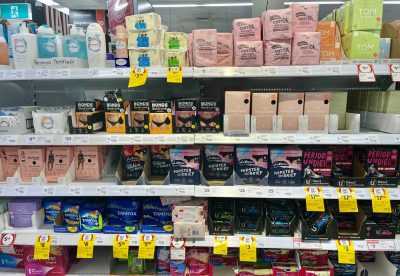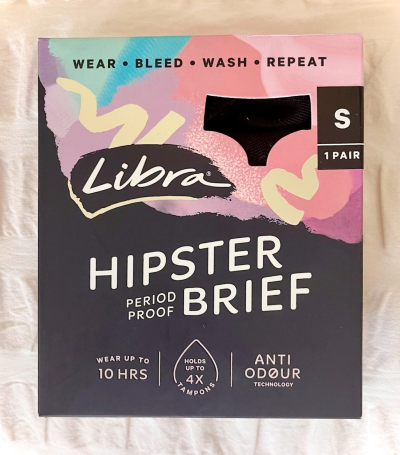Bleeding Green
Period care products are personal, practically by definition. Chances are that if you menstruate, you will have experienced an initiation into ‘womanhood’ through carefully explained or hastily taught methods of care in bathroom stalls. Generally, people find a product through trusted friends and family that share advice, and then stick with it for years.
However, the latest tampon supply chain shortage may force women to re-evaluate their preferred approach, as 7% of tampons were out of stock on a global scale.
The COVID-19 pandemic has impacted daily life beyond bare supermarket shelves. The great tampon shortage means that multi-billion dollar manufacturers are plagued by the same supply issues that COVID-19 has introduced for the last two years. This means tampon alternatives—such as menstrual cups, cloth pads, and period underwear—are increasingly becoming attractive options. Such products are washable, reusable, and only need to be bought once.
Another huge motivator for disposable alternatives is the movement against environmental destruction. My trip to Costco was a wake up call! It was overwhelming to spot bulk packages of 160 overnight pads. I can’t think of anyone hoarding their period packaging for the recycling bin. I never see reusable options on sale in regular grocery stores.

Great sales on pads and tampons…
Mega-corporations originally marketed disposable menstrual products as discreet tools for modern working women, but failed to disclose disastrous environmental fallout.
I decided to test the transition to an eco-conscious period with three peers, as we documented the shift to sustainable periods over the month. Collectively, the three said ta-ta to tampons and embraced period undies, the menstrual cup and reusable pads.
Tampons and pads were off the shopping list, as It’s estimated that menstruating individuals go through up to 15,000 of these products in a lifetime – mostly ending up in landfill. Consider how product wrapping and packaging generates more than 200, 000 metric tonnes of annual waste. To top it off, plastics take 500 to 800 years to decompose.
Part of sustainability is knowledgeable consumption, so we hope our evaluation will help you choose the perfect method for you!
Period Undies
UQ Student and environmental champion, Minelle Rodenberg embraced period underwear this month!

Picked these up from Coles!
So how do they work? Not so differently to your usual underwear, with the added ability to absorb menstrual flow. Moisture-absorbent leakproof layers allow this function, with look and feel of your everyday undies. They are washable and can be used in conjunction with pads or tampons for extra protection. Don’t underestimate them though, keep in mind they can absorb up to three tampons worth of blood!
“I loved them! So comfortable during the most painful week of the month. Only thing I felt uncomfortable about was the initial price, but they’re worth it in the long run.”
Menstrual Cup
Fellow UQ student, Tahlia Pratt, took on the menstrual cup.
Menstrual cups were one of the first major tampon competitors to break into the market. The cup is pretty easy to use, and is usually a latex or silicone funnel that is inserted into the vagina to collect menstrual blood. Unlike tampons, they don’t interfere with the vagina’s natural moisture and can be worn for up to 12 hours without the risk of toxic shock syndrome.
“Not gonna lie – I was so scared of spillage that I almost called in sick to work. I was so relieved when I didn’t even have to change my cup once during the longest shift of my life!”
The cups are estimated to save an individual 2,400 pads or tampons in their lifetime of use, with less than 1.5% environmental impact of disposables. However, benefits are often ignored due to stigmatization and the concept that cups are unsafe and will disrupt virginity.
Reusable pad
I’ll admit, I hadn’t heard of reusable pads until I began this journey. I immediately recoiled, as I envisioned bulky cloth pads, similar to nappies. Surprisingly advanced though!
Reusable pads are fun and flexible pieces of cotton, which snap around the underwear sides. In fact, they are fresher and breathe better than plastic disposables, as they aren’t made of suffocating materials. They last three to five years with adequate care, which involves a cold-cycle wash.
Environmental enthusiast, Jade Johnson, welcomed the challenge.
“Honestly, the only thing I had to change from my usual period routine was remembering to wash the used pad after work. I still felt just as comfortable!”
The downsides come with water requirements, which is in short supply in many third-world countries. Removal of germs with detergent is also problematic, as it is a pollutant and often inaccessible for people living in poverty who lack access to sanitation.
So what happens next month?
The United Nations established the Sustainable Development Goals as a blueprint for future planet prosperity against climate change. At its heart, the 17 Global Goals are an urgent call for action by all countries working in partnership to preserve economic and environmental peace by 2030.
Basically, at this stage the Sustainable Development Goals are the world’s best bet for unified progress. Goal advancement means that disposable products are out the window, as it takes centuries longer for a pad or tampon to deteriorate in landfill than the lifespan of the person that used it.
Our #iSustain journey highlighted the privilege of eco-friendly menstrual hygiene. Our trial revealed that sustainable period products may be inaccessible due to price, availability and education surrounding methods of use. Menstruators in rural areas with lower socioeconomic backgrounds often can’t find regular products alone. Menstrual hygiene is a human right, as safe bathing facilities are intrinsically connected to human dignity. Period poverty undermines this right, in environments where menstruation is stigmatized through gender inequality, poverty, cultural norms and humanitarian crises.
We found this journey intimidating regardless, stigmatization and accessibility obstacles aside. Exploring outside comfort zones is challenging, totally magnified when coupled with PMS symptoms. It’s undeniable that new experiences are daunting, however, they are also deeply rewarding. Bleeding Green has undoubtedly revolutionized our monthly routine and kick-started our journey of environmental mindfulness.
Our Bleeding Green journey was documented in an accompanying podcast. I host the Bleeding Green social initiative and hope you listen along as UQ students Minelle Rodenberg, Tahlia Pratt and Jade Johnson share their #iSustain stories of life beyond disposables.
If you’re curious about beginning your own Bleeding Green journey, join our eco-friendly sisterhood by following @bleeding.green.uq on Instagram! Our sustainable period survey results will be published there next week 🙂
This entry was inspired by the #iSustain community for the UQ Sustainability Office.
Reference List
Borunda, A. (2019, September 6). How tampons and pads became so unsustainable. Retrieved from National Geographic: https://www.nationalgeographic.com/environment/article/how-tampons-pads-became-unsustainable-story-of-plastic
Hait, A., & Powers, S. (2019). The value of reusable feminine hygiene products evaluated by comparative environmental life cycle assessment Author links open overlay panel. In Resources, Conservation and Recycling Vol. 150. Elsevier. Retrieved from https://www.sciencedirect.com/science/article/abs/pii/S0921344919303179
Kestler-D’Amours, J. (2022, June 17). https://www.aljazeera.com/news/2022/6/17/a-crisis-the-us-tampon-shortage-explainedhttps://www.aljazeera.com/news/2022/6/17/a-crisis-the-us-tampon-shortage-explained. Retrieved from Al Jazeera: https://www.aljazeera.com/news/2022/6/17/a-crisis-the-us-tampon-shortage-explained
Peberdy, E., Jones, A., & Green, D. (2019). A Study into Public Awareness of the Environmental Impact of Menstrual Products and Product Choice. In Sustainability Vol. 11 (2). Cambridge: Global Sustainability Institute. Retrieved from https://www.mdpi.com/2071-1050/11/2/473/htm
UNFPA. (2022, May). Menstruation and human rights – Frequently asked questions. Retrieved from United Nations Population Fund: https://www.unfpa.org/menstruationfaq
